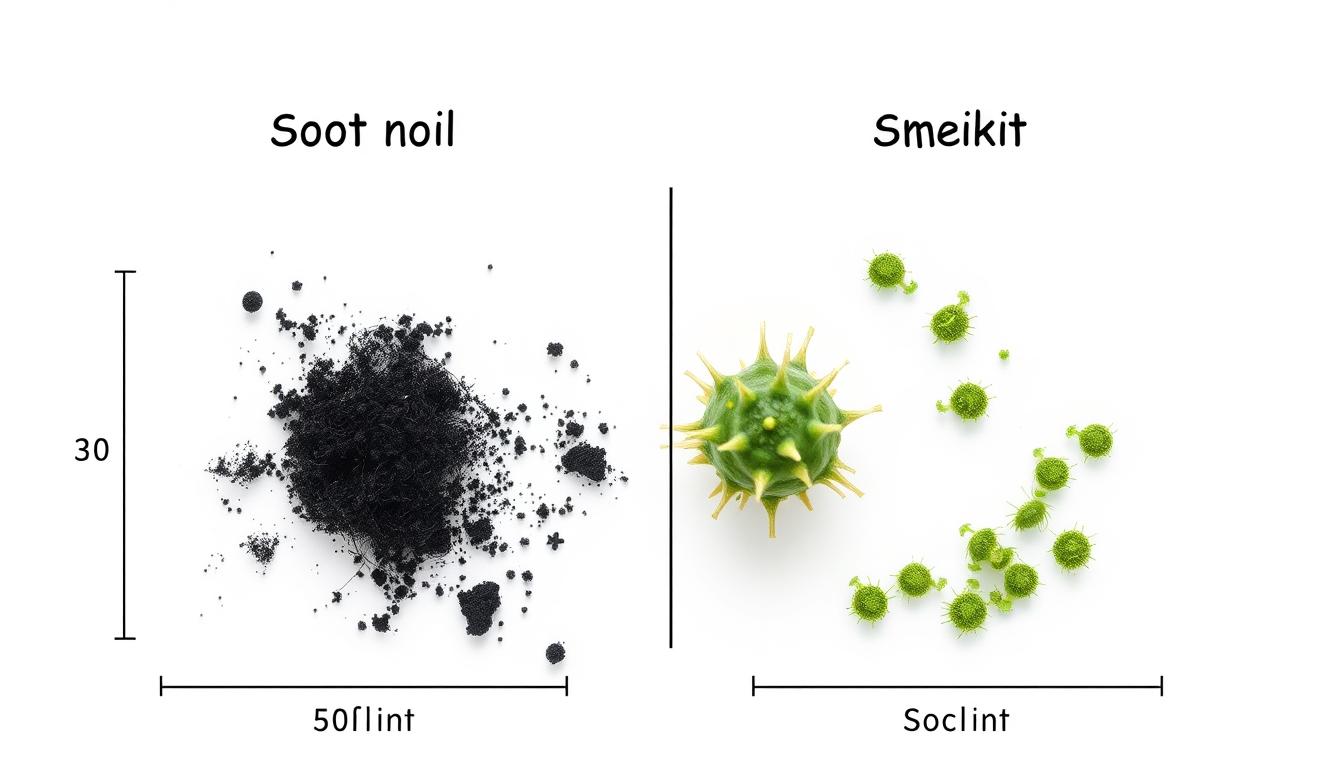When fire strikes your home or business, the visible flames are just the beginning of your challenges. The aftermath—persistent soot residue and potential mold growth—can cause lasting damage to your property and health if not properly addressed. Post-fire soot and mold cleanup requires specialized knowledge, appropriate safety equipment, and timely action to prevent secondary damage that often exceeds the initial fire damage.
This comprehensive guide will walk you through understanding the unique challenges of post-fire environments, essential safety precautions, professional cleanup techniques, and when to call in restoration experts. Whether you’re facing a small kitchen fire or extensive structural damage, these expert insights will help you navigate the complex restoration process with confidence.
Understanding Soot & Mold After Fires
Microscopic view: Soot particles (left) vs. mold spores (right) commonly found after fire damage
What Is Soot and Why Is It Dangerous?
Soot consists of fine black carbon particles created by incomplete combustion of materials during a fire. Unlike ash, which is generally gray and powdery, soot has an oily, sticky consistency that makes it cling tenaciously to surfaces. This characteristic makes post-fire soot cleanup particularly challenging.
Soot particles are extremely small—often less than 2.5 microns in diameter—allowing them to penetrate deep into lungs when inhaled. These particles contain various toxic compounds depending on what materials burned, including:
- Polycyclic aromatic hydrocarbons (PAHs)
- Acids that can corrode metals and etch glass
- Chemicals from burned synthetic materials
- Heavy metals and other carcinogens
The acidic nature of soot means it can continue causing damage long after the fire is extinguished. Within days, soot can permanently discolor porous materials, corrode metal fixtures, and damage electronic components.
How Mold Develops After Fire Damage
The connection between fire damage and mold growth isn’t immediately obvious, but firefighting efforts create ideal conditions for mold development. Water used to extinguish flames soaks into porous building materials, and without proper drying within 24-48 hours, mold begins to grow.
Post-fire environments often feature multiple mold growth factors:
- Water-saturated building materials from firefighting efforts
- High humidity from evaporating water
- Damaged ventilation systems that reduce air circulation
- Organic materials (wood, drywall, carpet) that serve as food sources for mold
Common mold species found after fire damage include Aspergillus, Penicillium, and Stachybotrys (black mold). These can cause respiratory issues, allergic reactions, and other health problems, particularly in individuals with pre-existing conditions.
Important: The combination of soot contamination and mold growth creates a particularly hazardous environment that requires professional-grade protective equipment and specialized cleaning techniques for safe remediation.
Safety Precautions for Post-Fire Soot and Mold Cleanup
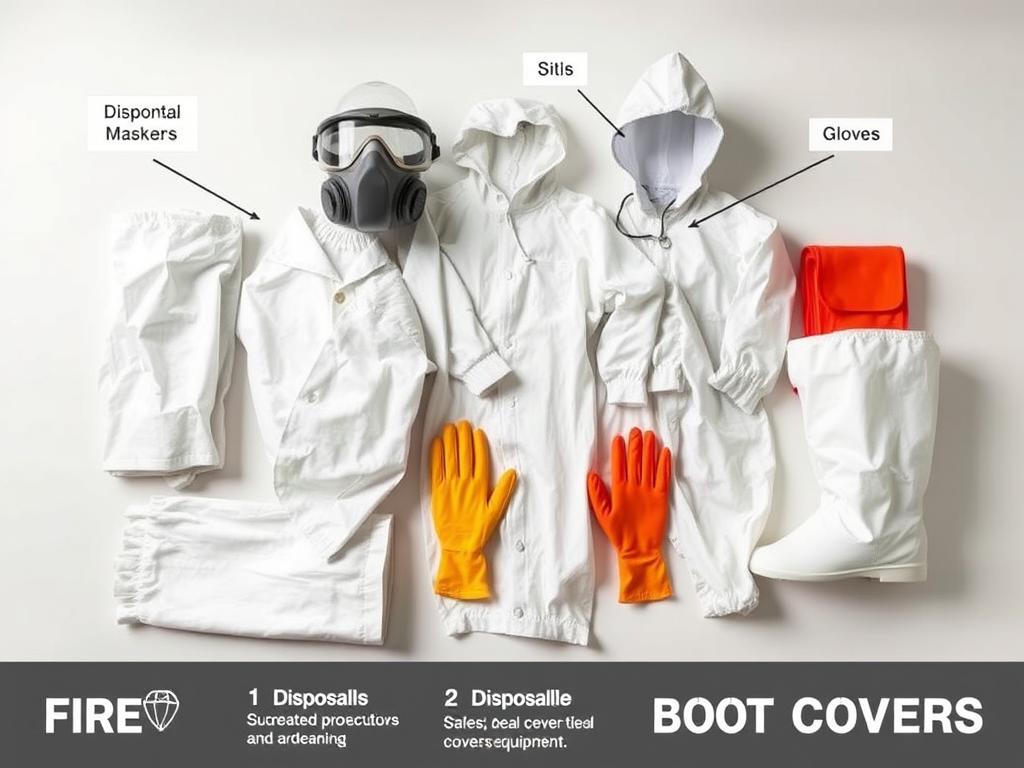
Essential personal protective equipment (PPE) for safe post-fire cleanup operations
Before attempting any post-fire soot and mold cleanup, proper safety measures are essential to protect yourself from both immediate and long-term health risks. The combination of soot particles and mold spores creates a particularly hazardous environment.
Required Personal Protective Equipment (PPE)
Respiratory Protection
- N95 respirator mask (minimum)
- P100 respirator with organic vapor cartridges (recommended for heavy soot)
- Full-face respirator for severe contamination
Skin Protection
- Disposable coveralls with hood
- Chemical-resistant gloves
- Boot covers or dedicated work boots
Eye Protection
- Safety goggles (if not using full-face respirator)
- Face shield for additional protection during heavy cleaning
Additional Safety Equipment
- First aid kit
- Emergency eyewash station or portable eyewash
- Fire extinguisher (in case of rekindling)
Proper Ventilation Techniques
Adequate ventilation is crucial during post-fire cleanup to reduce airborne contaminants and prevent cross-contamination to unaffected areas.
- Open windows and doors when weather permits
- Use box fans in windows to exhaust contaminated air outside
- Position fans to create directional airflow from clean areas toward contaminated areas
- Consider professional-grade air scrubbers with HEPA filtration
- Avoid using HVAC systems until they’ve been professionally cleaned
Containment Strategies
Proper containment prevents soot and mold spores from spreading to unaffected areas of your property during the cleanup process.
- Seal off work areas with plastic sheeting and painter’s tape
- Create negative air pressure in the containment area
- Establish clean rooms for entering/exiting the work area
- Use sticky mats at containment exits to capture particles on footwear
- Dispose of contaminated materials in sealed, heavy-duty plastic bags
Warning: Never attempt to clean extensive fire damage or visible mold growth without proper PPE. Soot particles and mold spores can cause serious respiratory issues and other health problems. When in doubt, consult with professional restoration specialists.
Step-by-Step Post-Fire Soot and Mold Cleanup Process
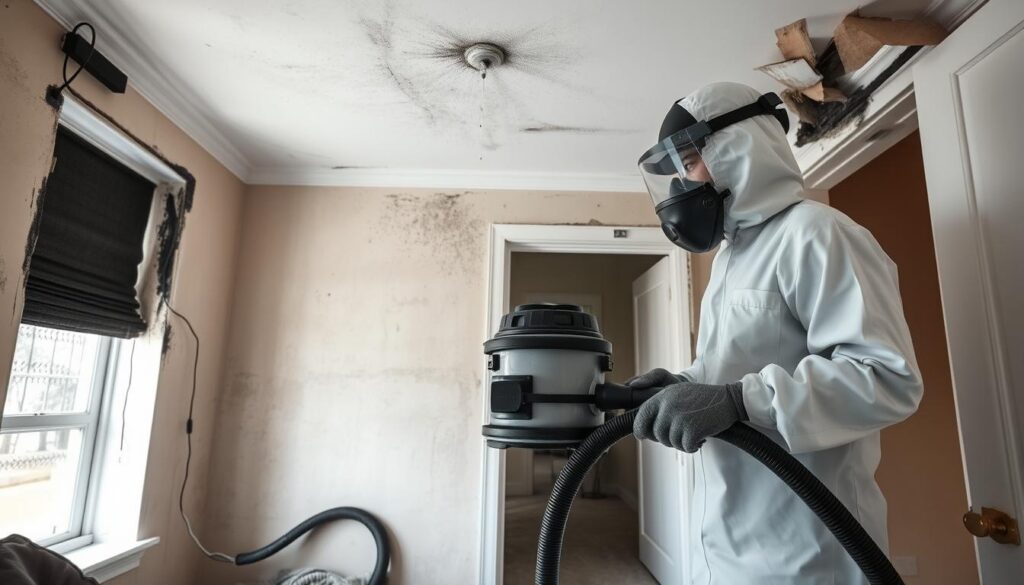
Professional technician using specialized equipment for effective soot removal
A systematic approach to post-fire soot and mold cleanup is essential for effective restoration. Following these steps will help ensure thorough remediation while minimizing health risks and preventing secondary damage.
Initial Assessment and Documentation
Before beginning any cleanup, thoroughly assess and document the damage for insurance purposes and to develop an effective remediation plan.
- Ensure the structure is safe to enter (get professional clearance if necessary)
- Photograph and video all damage before cleaning begins
- Identify the type of soot present (dry, wet, protein, or fuel oil)
- Test suspicious areas for mold growth using moisture meters and mold testing kits
- Create a detailed inventory of damaged items
Dry Cleaning Methods for Soot Removal
Begin with dry cleaning methods to remove loose soot particles before introducing moisture, which can drive soot deeper into porous surfaces.
- Use HEPA vacuums specifically designed for fine particles
- Apply chemical dry sponges (soot sponges) using light, overlapping strokes
- Work from top to bottom to prevent recontamination of cleaned areas
- Dispose of vacuum bags and soot sponges in sealed containers
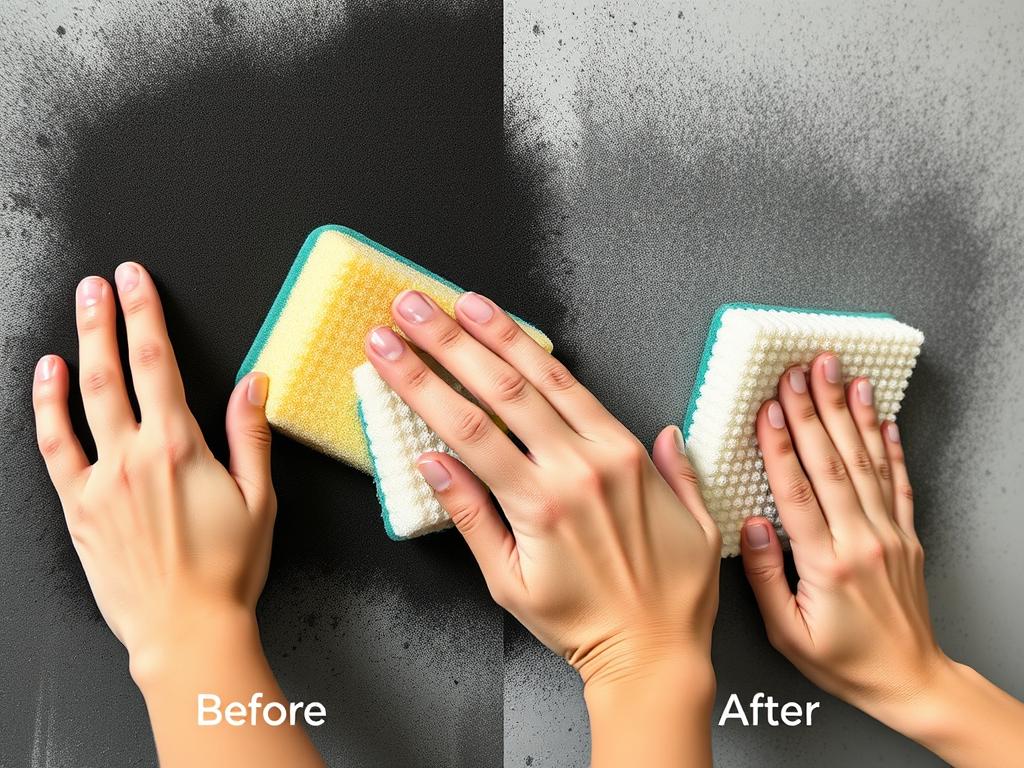
Proper technique for using chemical dry sponges on soot-covered surfaces
Wet Cleaning Techniques
After dry cleaning, wet cleaning methods can be used to remove residual soot and prepare surfaces for restoration.
- Test cleaning solutions on inconspicuous areas first
- Use specialized soot cleaners appropriate for the surface type
- For walls and hard surfaces, use a TSP (trisodium phosphate) solution
- Clean with microfiber cloths, changing them frequently
- Rinse thoroughly to remove all cleaning agents
Addressing Water Damage and Mold
Water used in firefighting efforts creates ideal conditions for mold growth, which must be addressed promptly.
- Extract standing water using pumps or wet vacuums
- Set up industrial dehumidifiers and air movers
- Monitor moisture levels in walls, floors, and other materials
- Remove and dispose of materials with visible mold growth
- Apply EPA-registered antimicrobial treatments to prevent mold regrowth
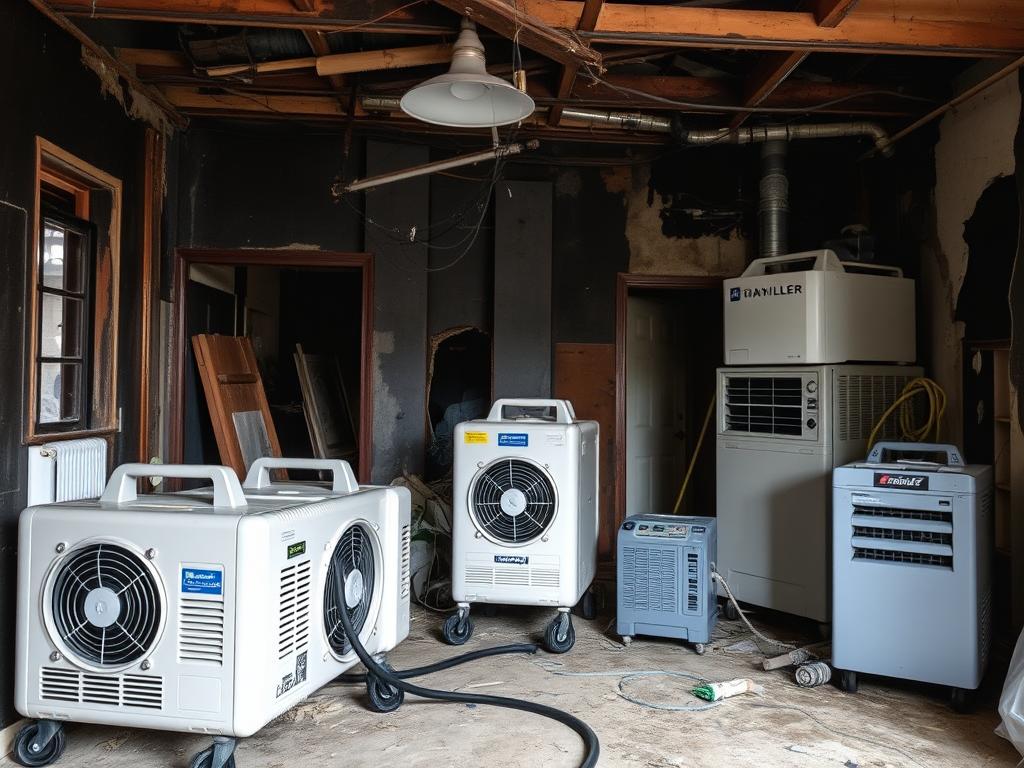
Professional drying equipment setup to prevent mold growth after fire damage
Cleaning Specific Materials and Surfaces
Hard Surfaces
- Glass: Vinegar solution or commercial glass cleaner
- Metal: Appropriate metal cleaner based on type
- Tile: Alkaline cleaner for soot, acid-based for mineral deposits
- Stone: pH-neutral cleaners to prevent etching
Porous Materials
- Wood: Dry clean first, then appropriate wood cleaner
- Drywall: Dry sponge, then primer and paint if salvageable
- Carpet: Professional hot water extraction
- Upholstery: HEPA vacuum, then professional cleaning
Personal Belongings
- Electronics: Professional restoration only
- Clothing: Specialized dry cleaning
- Documents: Freeze-drying and professional restoration
- Artwork: Consult art restoration specialists
Odor Removal Strategies
Smoke odor can persist long after visible soot is removed. Comprehensive odor removal requires multiple approaches:
- HEPA air scrubbers to filter airborne particles
- Ozone generators (used only in unoccupied spaces)
- Thermal fogging to penetrate materials with neutralizing agents
- Hydroxyl generators for occupied spaces
- Sealing of structural materials with odor-blocking primers
Final Cleaning and Restoration
Complete the cleanup process with these final steps:
- Perform a thorough final cleaning of all surfaces
- Replace HVAC filters and consider professional duct cleaning
- Apply antimicrobial treatments to prevent future mold growth
- Conduct clearance testing for soot particles and mold spores
- Begin restoration of damaged structural elements and finishes
Pro Tip: Document all cleaning procedures and keep receipts for materials and professional services for insurance purposes. Most insurance policies cover professional post-fire cleanup services.
When to Call Professionals for Post-Fire Soot and Mold Cleanup
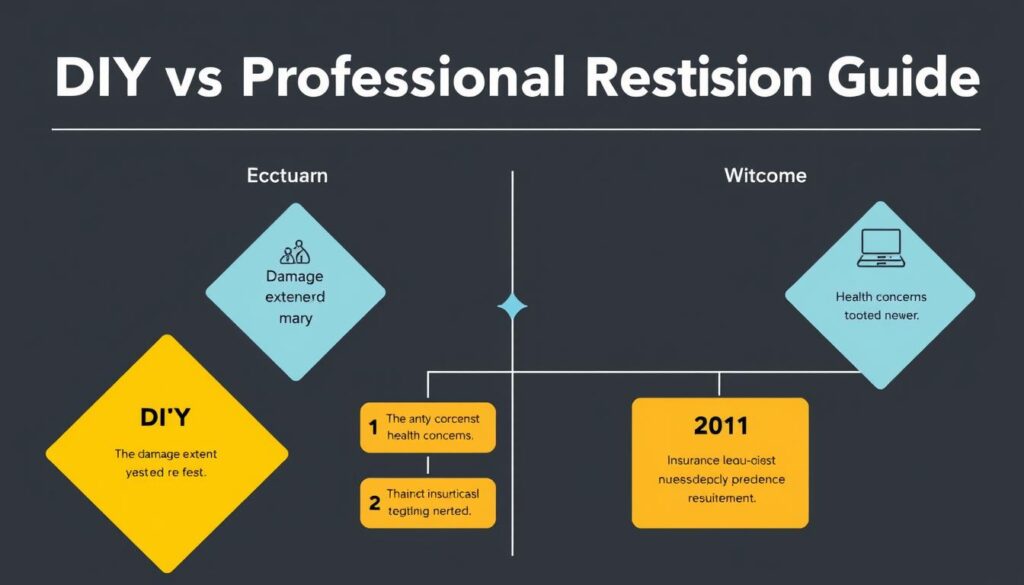
Decision guide: When to handle cleanup yourself vs. when to call professional restoration services
While minor soot residue from small incidents might be manageable with DIY methods, many post-fire scenarios require professional intervention. Understanding when to call in experts can save time, money, and protect your health.
Signs You Need Professional Help
Extent of Damage Indicators
- Soot covering more than a small, contained area
- Water damage from firefighting efforts
- Structural damage to walls, ceilings, or floors
- Damage to electrical systems or appliances
- Visible mold growth or musty odors
Health and Safety Concerns
- Residents with respiratory conditions, allergies, or compromised immune systems
- Presence of protein-based soot (from kitchen fires)
- Suspected presence of asbestos or lead in older buildings
- Persistent smoke odors despite cleaning attempts
- Lack of proper safety equipment or training
Benefits of Professional Restoration Services
Professional Advantages
- Specialized equipment not available to consumers
- Comprehensive insurance coverage documentation
- Proper containment to prevent cross-contamination
- Expert assessment of structural safety
- Knowledge of appropriate cleaning methods for different materials
- Ability to salvage items that might otherwise be discarded
- Complete odor removal using industrial techniques
DIY Limitations
- Risk of inadequate cleaning leading to long-term damage
- Potential health exposure without proper equipment
- Limited access to professional-grade cleaning agents
- Difficulty addressing hidden contamination
- Risk of spreading soot to unaffected areas
- Inability to properly test for complete remediation
- Time-consuming process without specialized tools
What to Expect from Professional Restoration
Understanding the professional restoration process helps you know what to expect when hiring experts:
- Initial Assessment: Thorough inspection and documentation of damage
- Emergency Services: Board-up, tarping, water extraction if needed
- Detailed Estimate: Comprehensive plan and cost breakdown
- Insurance Coordination: Direct communication with your insurance provider
- Containment Setup: Isolation of affected areas to prevent cross-contamination
- Soot and Debris Removal: Specialized cleaning of all affected surfaces
- Water Damage Mitigation: Drying and dehumidification
- Mold Remediation: If present, following EPA protocols
- Odor Treatment: Multiple methods to eliminate smoke odor
- Content Cleaning: On-site or pack-out cleaning of belongings
- Structural Repairs: Restoration of damaged building materials
- Final Cleaning: Comprehensive cleaning of the entire affected area
- Clearance Testing: Verification that remediation is complete
“The difference between DIY cleanup and professional restoration isn’t just in the results—it’s in the peace of mind knowing that hidden dangers have been properly addressed and your property is truly safe again.”
Frequently Asked Questions About Post-Fire Soot and Mold Cleanup
Can mold grow after a fire?
Yes, mold commonly grows after fires due to water used in firefighting efforts. When water soaks into building materials and isn’t properly dried within 24-48 hours, mold can begin growing. Additionally, damaged ventilation systems and high humidity from evaporating water create ideal conditions for mold development. Professional restoration services include moisture monitoring and proper drying techniques specifically to prevent post-fire mold growth.
How long does soot cleanup take?
The timeline for complete post-fire soot and mold cleanup varies significantly based on the extent of damage, size of the affected area, and materials involved. For small, contained incidents (like a minor kitchen fire), professional cleanup might take 2-3 days. For moderate to severe fire damage affecting multiple rooms, the process typically takes 2-4 weeks. Complex situations involving structural damage, extensive water damage, or mold growth can extend the timeline to several months, especially when reconstruction is needed.
Is soot dangerous to touch?
Yes, soot is dangerous to touch. Soot particles contain toxic chemicals and carcinogens that can be absorbed through the skin. Direct contact can cause skin irritation, chemical burns, and long-term health issues. Additionally, touching soot can grind particles deeper into porous surfaces, making cleanup more difficult. Always wear chemical-resistant gloves when handling soot-affected items and avoid touching soot residue with bare skin.
Will insurance cover professional post-fire cleanup?
Most homeowner’s and business insurance policies cover professional post-fire soot and mold cleanup services as part of fire damage restoration. This typically includes emergency services, soot removal, odor elimination, and remediation of water damage from firefighting efforts. However, coverage limits and deductibles vary by policy. It’s important to contact your insurance provider immediately after a fire and document all damage thoroughly. Professional restoration companies often work directly with insurance adjusters to streamline the claims process.
How do I get smoke smell out of my house after a fire?
Removing smoke odor after a fire requires a multi-faceted approach. Start by removing all soot-contaminated materials and thoroughly cleaning all surfaces. Air purifiers with HEPA and activated carbon filters can help remove airborne particles. For persistent odors, professional techniques like thermal fogging, ozone treatment, and hydroxyl generation are most effective as they neutralize odor molecules rather than masking them. In severe cases, sealing structural materials with odor-blocking primers before repainting may be necessary. Professional restoration services offer comprehensive odor removal that DIY methods typically cannot achieve.
What cleaning products work best for soot removal?
The most effective cleaning products for soot removal depend on the surface type and soot characteristics. For initial dry cleaning, chemical sponges (also called dry cleaning sponges) are essential as they lift soot without smearing. For wet cleaning hard surfaces, a solution of trisodium phosphate (TSP) and water is effective. Commercial soot removers like Simple Green, Lestoil, or specialized restoration products like Unsmoke’s Wall Wash are also effective. For delicate surfaces, less aggressive cleaners like diluted dish soap may be appropriate. Always test cleaning solutions on an inconspicuous area first and follow manufacturer instructions.
Can I stay in my home during post-fire cleanup?
Whether you can safely remain in your home during post-fire soot and mold cleanup depends on several factors. For minor, contained incidents where damage is limited to a single area, you may be able to stay while work is performed with proper containment. However, for moderate to severe fire damage, professional restoration companies typically recommend temporary relocation due to health hazards from airborne soot particles, potential structural safety issues, and the disruptive nature of the cleanup process. Additionally, techniques like ozone treatment require the property to be completely unoccupied. Your insurance policy may cover temporary housing costs during restoration.
Protecting Your Health and Property After Fire Damage
Post-fire soot and mold cleanup is a complex process that requires careful attention to safety, proper techniques, and thorough remediation to prevent long-term damage to both your property and health. While minor incidents might be manageable with DIY methods, most fire damage scenarios benefit significantly from professional restoration services.
Remember that the visible soot is often just the surface of the problem. Microscopic particles can penetrate deep into materials, and water damage from firefighting efforts creates ideal conditions for mold growth. Taking prompt, appropriate action is essential to minimize secondary damage and restore your property to a safe, healthy condition.
Whether you choose to tackle cleanup yourself or hire professionals, prioritize safety with proper protective equipment, containment, and ventilation. Document everything for insurance purposes, and don’t hesitate to call in experts if you encounter extensive damage, persistent odors, or visible mold growth.
With the right approach and timely action, your property can be successfully restored after fire damage, allowing you and your family to return to a safe, healthy environment.
Need Emergency Fire Damage Assistance?
Our certified restoration specialists are available 24/7 to help with post-fire soot and mold cleanup. Don’t risk your health with improper cleanup methods.
Our service areas for post-fire soot and mold cleanup
Get Expert Help With Post-Fire Soot and Mold Cleanup
Don’t risk your health or property with improper cleanup methods. Our certified restoration specialists provide comprehensive post-fire soot and mold remediation services to restore your home safely and effectively.
Schedule Your Free Damage Assessment
Or call our 24/7 emergency response line:
